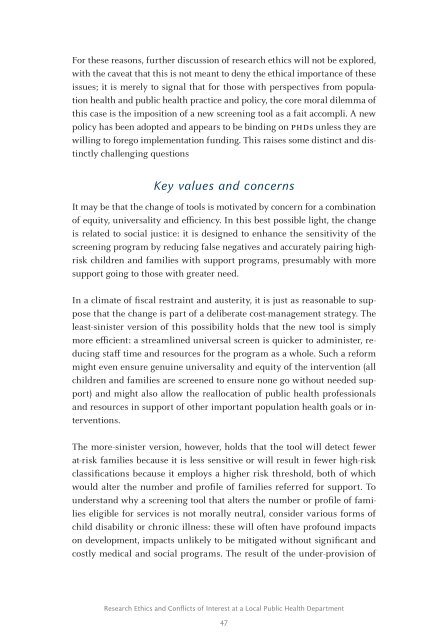PoPulationand Public HealtH etHics
PoPulationand Public HealtH etHics
PoPulationand Public HealtH etHics
You also want an ePaper? Increase the reach of your titles
YUMPU automatically turns print PDFs into web optimized ePapers that Google loves.
For these reasons, further discussion of research ethics will not be explored,<br />
with the caveat that this is not meant to deny the ethical importance of these<br />
issues; it is merely to signal that for those with perspectives from population<br />
health and public health practice and policy, the core moral dilemma of<br />
this case is the imposition of a new screening tool as a fait accompli. A new<br />
policy has been adopted and appears to be binding on PHDs unless they are<br />
willing to forego implementation funding. This raises some distinct and distinctly<br />
challenging questions<br />
Key values and concerns<br />
It may be that the change of tools is motivated by concern for a combination<br />
of equity, universality and efficiency. In this best possible light, the change<br />
is related to social justice: it is designed to enhance the sensitivity of the<br />
screening program by reducing false negatives and accurately pairing highrisk<br />
children and families with support programs, presumably with more<br />
support going to those with greater need.<br />
In a climate of fiscal restraint and austerity, it is just as reasonable to suppose<br />
that the change is part of a deliberate cost-management strategy. The<br />
least-sinister version of this possibility holds that the new tool is simply<br />
more efficient: a streamlined universal screen is quicker to administer, reducing<br />
staff time and resources for the program as a whole. Such a reform<br />
might even ensure genuine universality and equity of the intervention (all<br />
children and families are screened to ensure none go without needed support)<br />
and might also allow the reallocation of public health professionals<br />
and resources in support of other important population health goals or interventions.<br />
The more-sinister version, however, holds that the tool will detect fewer<br />
at-risk families because it is less sensitive or will result in fewer high-risk<br />
classifications because it employs a higher risk threshold, both of which<br />
would alter the number and profile of families referred for support. To<br />
understand why a screening tool that alters the number or profile of families<br />
eligible for services is not morally neutral, consider various forms of<br />
child disability or chronic illness: these will often have profound impacts<br />
on development, impacts unlikely to be mitigated without significant and<br />
costly medical and social programs. The result of the under-provision of<br />
Research Ethics and Conflicts of Interest at a Local <strong>Public</strong> Health Department<br />
47
















